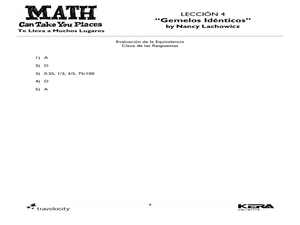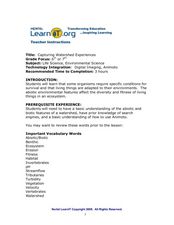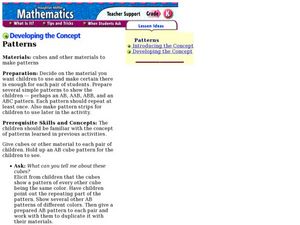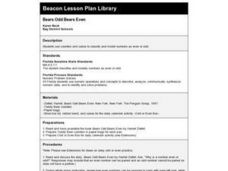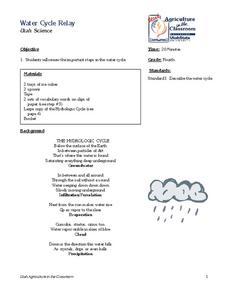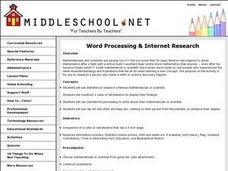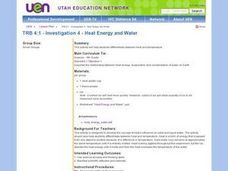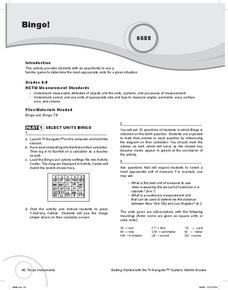Curated OER
Patterns
Second graders work with different types of patterns. In this pattern instructional activity, 2nd graders go to a pattern block webpage and use Unifix cubes to create their own patterns. They find patterns in the real world and draw...
Curated OER
Fractions
Students observe and demonstrate a variety of activities to identify the fraction parts and the symbols they represent. As a class they explore different fractions using unifix cubes, then use the cubes to build and discuss the...
Curated OER
Partners for the Common Good: One Day
Fourth graders explore the concept of philanthropy. In this service learning lesson, 4th graders compare for profit and nonprofit organizations. Students explore nonprofit organizations in their community and discuss their philanthropic...
Curated OER
Show Me the Money
Students review the terms in the "Money Vocabulary Word Bank." They make a wallet or purse to keep their money in. Students learn the song "Show Me the Money." They participate in five centers: 1) Head or Tails Tally, 2) Piggy Bank...
Curated OER
Rainbow Fish: The Copycat Fish Lesson Plan
Learners explore the concept of copying one another. In this early childhood lesson plan, students discuss what a copycat is and why people copy one another. Learners then discuss the story Rainbow Fish: The Copycat Fish, recording...
Curated OER
Identical Twins
Sixth graders work with equivalent fractions, decimals, and percents. In this equivalency lesson, 6th graders participate in a number of activities aimed at increasing their understanding of equivalent expressions. They form a human...
Curated OER
Capturing Watershed Experiences
Young scholars observe organisms found in the water. In this lesson on organisms, students collect water from local streams and tributaries in order to study the organisms found in the water. As a culminating activity, young scholars...
University of Colorado
Rings and Things
Galileo first observed Saturn's rings in 1610. Through the use of a flashlight and baby powder, classes see how they can observe the rings of the outer planets from far away. Another demonstration shows how these rings, made of ice and...
Curated OER
Kindergarten Numbers and Number Sense
Twelve math lessons take kindergartners through the process of number sense and counting. The skills range from counting to ten, filling out ten frames, indicating ordinal position of an object, and counting by fives and tens to one...
Curated OER
What's the Best Deal?
Young scholars explore number sense by solving consumer math problems. In this pattern identification lesson, students analyze a list of numerical and geometric patterns while predicting the future outcome. Young scholars utilize...
Curated OER
Prime and Composite Numbers
Fifth graders use prime factorization to identify prime and composite numbers. They use cubes to find factors. In groups, 5th graders draw rectangular arrays to discover prime numbers under 100.
Curated OER
Developing the Concept: Patterns
Students understand what a pattern is and how to make a pattern. In this pattern instructional activity, students use cubes to create various patterns. Students recognize the pattern created.
Curated OER
Measure Mania
Students measure their own silhouette using Unifix cubes. They measure a drawing using non-standard measurement. They swap drawings and compare their measurements.
Curated OER
Bears Odd Bears Even
Students listen to a read aloud of Harriet Ziefert's Bears Odd Bears Even. They count cubes and counters to classify and show numbers as odd or even.
Curated OER
Water Cycle Relay
Fourth graders study the water cycle in nature. In this water cycle lesson, 4th graders review the hydrologic cycle by reading the poem. Students then study a picture of the hydrologic cycle and fill in the blanks with the missing...
Curated OER
Explore Three-Dimensional Shapes
Students are assigned to shape groups and explore three-dimensional shapes. They review math skills and two-dimensional shapes.
Curated OER
Happy Birthday Mathematicians and Me
Middle schoolers choose a mathematician or scientist born on the same day as the student and research them. They create a cube or tetrahedron and place required information on the sides (such as birth year, death yr., greatest...
Curated OER
Estimating Sums and Differences
In this math worksheet, students learn to estimate sums and differences by completing step by step exercises. There is one word problem which is the example, and then students can choose from other estimation activities to do with a...
Curated OER
Our Geometric World
Third graders explore the attributes of polygons. In this geometric shapes lesson, 3rd graders review quadrilaterals, squares, rectangles, triangles, pentagons, hexagons, and octagons in order to create hanging polygons. Students then...
Curated OER
Heat Energy and Water
Fourth graders brainstorm the differences between heat and temperature. In groups, they determine the best way to melt ice without touching the ice. They record their observations and compare them with other groups. To end the lesson,...
Curated OER
The Length of my Foot
Students review the concept of measuring length. In groups, they travel to various centers throughout the classroom. They experiment with using different objects to measure the length of items given to them by their teacher. They are...
Curated OER
Addition Facts With Sums to 18
Students explore addition facts with sums to 18. Using Unifix cubes, students demonstrate addition sentences. They use a variety of manipulatives to illustrate addition facts for different sums. Students participate in a flash card game...
Curated OER
Bingo
Students practice determining the most appropriate units for a given situation while measuring attributes of objects, systems and processes of measurement. They review the concepts of angles, perimeter, area, surface area and volume.
Curated OER
Who Needs Numbers?
Students identify whole numbers through the one millions place. In this place value lesson, students read the book The Day Without Math and use place value mats to create numbers to the millions place. Students use base ten blocks during...







